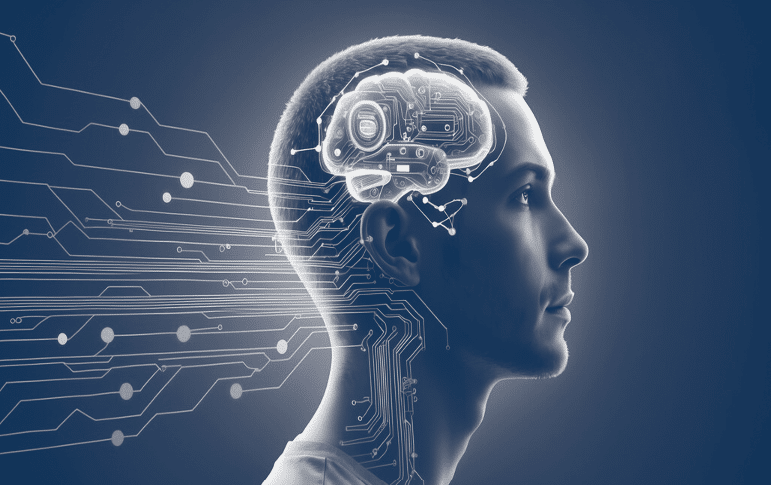
What is Artificial Intelligence? A Beginner’s Guide to Understanding AI
Have you ever wondered how your phone suggests the next word you type, or how Netflix knows exactly what show you’ll love? Perhaps you’ve marveled at self-driving cars or chatted with a helpful customer service bot online. All of these seemingly magical feats are powered by something called Artificial Intelligence, or AI.
Once confined to the realm of science fiction, AI is now an integral part of our daily lives, quietly working behind the scenes to make things smarter, faster, and more efficient. But what exactly is Artificial Intelligence? And how does it work?
If you’re a beginner curious about this revolutionary technology, you’ve come to the right place. This comprehensive guide will demystify AI, breaking down complex concepts into easy-to-understand language.
What Exactly is Artificial Intelligence (AI)?
At its core, Artificial Intelligence (AI) refers to the simulation of human intelligence processes by machines, especially computer systems. In simpler terms, it’s about teaching computers to "think" and "learn" in ways that mimic human cognitive abilities.
Think of it like this: just as humans can learn from experience, solve problems, understand language, recognize faces, and make decisions, AI aims to equip machines with similar capabilities.
Key characteristics of Artificial Intelligence include:
- Learning: AI systems can acquire information and rules for using the information. This often involves machine learning, where systems learn from data without being explicitly programmed for every scenario.
- Reasoning: They can apply rules to data to reach approximate or definite conclusions. This involves logical deduction and problem-solving.
- Problem-Solving: AI can analyze a given problem and devise a plan or strategy to achieve a specific goal.
- Perception: Through technologies like computer vision, AI can interpret visual information (images, videos) or auditory information (speech).
- Understanding Language: Natural Language Processing (NLP) allows AI to understand, interpret, and generate human language.
- Decision-Making: Based on the data and learning, AI systems can make autonomous decisions or provide recommendations.
It’s important to note that AI isn’t a single technology, but rather a broad field encompassing many different techniques and applications designed to make machines smarter.
A Brief History of AI: From Dreams to Reality
While AI feels like a modern phenomenon, its roots stretch back much further than you might think.
- Ancient Beginnings: The idea of artificial beings with intelligence dates back to ancient myths and legends, with tales of automatons and Golems.
- Early Concepts (1940s-1950s): The formal study of AI began with pioneering computer scientists and mathematicians like Alan Turing, who pondered whether machines could "think." The concept of the "Turing Test" (a test of a machine’s ability to exhibit intelligent behavior equivalent to, or indistinguishable from, that of a human) emerged in 1950.
- The Dartmouth Workshop (1956): This pivotal summer workshop, organized by John McCarthy, Marvin Minsky, Nathaniel Rochester, and Claude Shannon, is widely considered the birthplace of AI as an academic discipline. It was here that the term "Artificial Intelligence" was coined.
- Early Enthusiasm and "AI Winters" (1960s-1990s): The early decades saw significant optimism, with researchers making bold predictions. However, limitations in computing power, data, and algorithms led to periods of reduced funding and interest, often referred to as "AI winters."
- The Resurgence (2000s-Present): The 21st century has seen an unprecedented boom in AI, driven by several key factors:
- Big Data: The explosion of digital data (text, images, videos) provides the fuel for AI algorithms to learn from.
- Increased Computing Power: Modern processors (especially GPUs) can handle the massive computations required for complex AI models.
- Advanced Algorithms: Significant breakthroughs in machine learning, particularly deep learning, have made AI more effective than ever before.
Today, AI is no longer just an academic pursuit; it’s a practical tool transforming industries worldwide.
How Does AI Work? The Basics Explained
AI isn’t magic, though it might seem like it sometimes! At its core, AI works by using algorithms to find patterns and make predictions or decisions based on data.
Imagine you want to teach a child to identify a cat. You’d show them many pictures of cats, point out their features (whiskers, ears, tail), and tell them, "This is a cat." You’d also show them pictures of dogs or other animals and say, "This is not a cat." Over time, the child learns to recognize cats independently.
AI systems learn in a similar, but much more complex, way:
- Data is the Fuel: AI systems are fed massive amounts of data. For instance, to teach an AI to recognize cats, you’d feed it millions of images labeled as "cat" or "not cat."
- Algorithms are the Recipes: These are sets of rules or instructions that the AI follows to process the data. An algorithm might look for specific features in images (like edges, shapes, colors) and try to correlate them with the "cat" label.
- Pattern Recognition: The AI algorithm analyzes the data to identify patterns, relationships, and correlations. It learns what features are most indicative of a cat.
- Learning and Refinement: Just like a child learns from mistakes, AI systems refine their understanding. If the AI misidentifies a dog as a cat, it adjusts its internal parameters based on feedback, improving its accuracy over time. This iterative process of learning and refinement is crucial.
- Prediction/Decision: Once trained, the AI can then apply its learned knowledge to new, unseen data. If you show it a new picture, it can predict whether it’s a cat or not, based on the patterns it learned.
The "brain" of many modern AI systems is a model – a mathematical representation of the patterns and relationships it has learned from the data.
Key Branches of Artificial Intelligence
AI is a vast field, and it’s helpful to understand some of its most prominent sub-disciplines:
1. Machine Learning (ML)
Machine Learning is the most popular and widely used branch of AI. It’s the science of getting computers to learn without being explicitly programmed. Instead of writing code for every possible scenario, you give the machine data and an algorithm, and it "learns" from that data to perform a task.
Think of ML as the engine that powers many AI applications.
Types of Machine Learning:
- Supervised Learning: This is like learning with a teacher. The AI is given labeled data (input data paired with the correct output). It learns to map inputs to outputs.
- Example: Training an AI to identify spam emails by feeding it millions of emails already labeled as "spam" or "not spam."
- Unsupervised Learning: This is like learning by exploration. The AI is given unlabeled data and has to find patterns, structures, or relationships within it on its own.
- Example: Grouping customers into different segments based on their purchasing behavior without prior knowledge of those segments.
- Reinforcement Learning: This is like learning through trial and error, similar to how a child learns to ride a bike. An AI agent learns to perform actions in an environment to maximize a reward.
- Example: Training an AI to play chess or video games, where it learns optimal moves by receiving "rewards" for good actions and "penalties" for bad ones.
2. Deep Learning (DL)
Deep Learning is a specialized subset of Machine Learning that uses Artificial Neural Networks (ANNs) with many layers (hence "deep") to learn from vast amounts of data. These neural networks are inspired by the structure and function of the human brain.
- How it Works: Each "layer" in a deep neural network processes data at a different level of abstraction, learning increasingly complex features. For example, in image recognition, one layer might detect edges, the next shapes, and subsequent layers complete objects like faces or cars.
- Power: Deep learning models are incredibly powerful for tasks involving large, unstructured data like images, audio, and text.
- Example: The technology behind facial recognition, speech assistants, and highly accurate image classification.
3. Natural Language Processing (NLP)
NLP focuses on enabling computers to understand, interpret, and generate human language. It bridges the gap between human communication and computer comprehension.
- Applications:
- Chatbots and Virtual Assistants: Siri, Alexa, Google Assistant.
- Language Translation: Google Translate.
- Sentiment Analysis: Determining the emotional tone of text (e.g., positive, negative, neutral) in customer reviews.
- Spam Detection: Filtering unwanted emails.
4. Computer Vision (CV)
Computer Vision allows machines to "see" and interpret the visual world. It involves enabling computers to derive meaningful information from digital images, videos, and other visual inputs.
- Applications:
- Facial Recognition: Unlocking your phone with your face.
- Object Detection: Identifying cars, pedestrians, and traffic signs in self-driving cars.
- Medical Imaging Analysis: Helping doctors detect diseases from X-rays or MRIs.
- Quality Control in Manufacturing: Spotting defects on assembly lines.
5. Robotics
While not purely an AI field, Robotics often integrates AI to create intelligent machines that can interact with the physical world. AI powers a robot’s ability to perceive its environment, navigate, manipulate objects, and make autonomous decisions.
- Applications:
- Industrial Robots: Performing repetitive tasks in factories.
- Surgical Robots: Assisting surgeons with precision.
- Autonomous Drones: For delivery or surveillance.
- Household Robots: Robotic vacuum cleaners.
Real-World Applications of AI: AI in Your Daily Life
AI isn’t just for scientists in labs; it’s woven into the fabric of our everyday lives. Here are just a few examples:
- Smartphones:
- Voice Assistants: Siri, Google Assistant, Bixby.
- Facial Recognition: Unlocking your phone.
- Predictive Text & Autocorrect: Helping you type faster.
- Smart Camera Features: Optimizing photo settings.
- Entertainment & Media:
- Recommendation Systems: Netflix, Spotify, YouTube suggesting content you’ll like.
- Content Creation: AI-generated music, art, or even written articles.
- Gaming: AI opponents that adapt to your play style.
- Navigation & Transportation:
- GPS Apps: Optimizing routes based on real-time traffic (Google Maps, Waze).
- Self-Driving Cars: Detecting objects, navigating roads, making driving decisions.
- Ride-Sharing Services: Efficiently matching drivers with riders.
- Healthcare:
- Disease Diagnosis: Analyzing medical images (X-rays, MRIs) to detect anomalies.
- Drug Discovery: Accelerating the research and development of new medications.
- Personalized Treatment Plans: Tailoring therapies based on a patient’s genetic profile and medical history.
- Finance:
- Fraud Detection: Identifying suspicious transactions.
- Algorithmic Trading: AI-powered systems executing trades at high speeds.
- Credit Scoring: Assessing creditworthiness.
- Customer Service:
- Chatbots: Providing instant answers to common questions.
- Call Center Automation: Routing calls and assisting agents.
- Retail & E-commerce:
- Personalized Shopping Experiences: Recommending products based on past purchases.
- Inventory Management: Predicting demand to optimize stock levels.
- Targeted Advertising: Showing ads relevant to your interests.
Benefits of Artificial Intelligence
The widespread adoption of AI is driven by its significant advantages:
- Automation of Repetitive Tasks: AI can take over mundane, high-volume tasks, freeing up human workers for more creative and complex work.
- Increased Efficiency and Speed: AI systems can process vast amounts of data and perform tasks far more quickly and consistently than humans.
- Improved Accuracy and Reduced Errors: By learning from data, AI can make highly accurate predictions and decisions, minimizing human error.
- Better Decision-Making: AI can analyze data patterns that are invisible to the human eye, leading to more informed and data-driven decisions.
- Solving Complex Problems: AI is being used to tackle some of humanity’s biggest challenges, from climate change to disease research.
- Personalization: AI enables highly tailored experiences, whether it’s product recommendations, educational content, or healthcare plans.
- Innovation: AI is a catalyst for new technologies and services, driving economic growth and societal advancement.
Challenges and Ethical Considerations of AI
While the benefits of AI are immense, it’s crucial to acknowledge the challenges and ethical questions it raises:
- Job Displacement: As AI automates tasks, there are concerns about job losses in certain sectors. The focus shifts to job retraining and the creation of new roles.
- Bias and Fairness: AI systems learn from the data they’re fed. If the data is biased (e.g., reflecting societal prejudices), the AI can perpetuate or even amplify those biases, leading to unfair or discriminatory outcomes.
- Privacy Concerns: AI often requires access to large amounts of personal data, raising questions about data security, privacy, and how information is used.
- Accountability: Who is responsible when an AI system makes a mistake or causes harm (e.g., in autonomous vehicles or medical diagnosis)?
- Lack of Transparency (The "Black Box" Problem): Some advanced AI models, especially deep learning networks, can be so complex that it’s difficult for humans to understand why they make a particular decision. This "black box" problem poses challenges in critical applications.
- Security Risks: AI systems can be vulnerable to attacks, where malicious actors try to trick or manipulate them.
- Control and Autonomy: As AI becomes more sophisticated, questions arise about the level of autonomy we grant to machines and how to ensure human control.
Addressing these challenges requires careful thought, robust regulations, and a focus on developing responsible AI.
The Future of AI: What’s Next?
AI is not a static field; it’s constantly evolving at an incredible pace. Here’s a glimpse of what the future might hold:
- Even Deeper Integration: AI will become even more seamlessly integrated into our homes, workplaces, and cities, often working in the background without us even realizing it.
- Smarter Assistants and Interfaces: Expect more sophisticated conversational AI, personalized education, and intuitive interfaces that understand us better.
- Breakthroughs in Science and Medicine: AI will continue to accelerate discovery in areas like materials science, personalized medicine, and climate modeling.
- Autonomous Systems: Self-driving vehicles, delivery drones, and intelligent robots will become more common and capable.
- Explainable AI (XAI): A growing area of research focusing on making AI models more transparent and understandable, addressing the "black box" problem.
- Ethical AI Development: Increased focus on creating AI that is fair, unbiased, secure, and respects privacy, with robust ethical guidelines and regulations.
Conclusion: Embracing the Intelligent Future
Artificial Intelligence is no longer a futuristic concept; it’s a powerful and pervasive technology that is reshaping our world. From understanding your voice commands to powering medical breakthroughs, AI is enhancing efficiency, driving innovation, and solving problems in ways we once only dreamed of.
As a beginner, understanding AI means grasping its core concept – teaching machines to learn and think like humans – and recognizing its key branches and countless applications. While challenges and ethical considerations exist, the ongoing development of AI, guided by responsible practices, promises a future filled with incredible possibilities.
The journey into understanding AI has just begun, and the more we learn about it, the better equipped we’ll be to navigate and contribute to our increasingly intelligent world.
Frequently Asked Questions about AI (FAQs)
Q1: Is AI going to take over the world?
A: No, not in the way science fiction often portrays. Current AI is "narrow AI" or "weak AI," meaning it’s designed to perform specific tasks. We are far from "strong AI" or "general AI" that could possess consciousness or human-like intelligence across all domains. While ethical considerations are crucial, the focus is on developing AI responsibly and keeping humans in control.
Q2: Is AI the same as robots?
A: Not exactly. AI is the "brain" or the intelligence behind a system. Robotics involves the physical machines. Many robots use AI to perceive, navigate, and make decisions, but a robot doesn’t necessarily have AI, and AI doesn’t always need a physical robot (e.g., a chatbot is AI without a robot).
Q3: Is AI dangerous?
A: Like any powerful technology, AI has the potential for both immense good and misuse. The dangers lie not in AI becoming sentient and evil, but in issues like biased data leading to unfair outcomes, privacy violations, or its use in autonomous weapons. Responsible development and ethical guidelines are essential to mitigate these risks.
Q4: Do I need to be a programmer to understand AI?
A: No! This guide proves you don’t need to be a programmer to understand the fundamental concepts and applications of AI. While a technical background is helpful for developing AI, everyone can benefit from understanding how it impacts their lives and society.
Q5: How can I learn more about AI?
A: There are many resources! You can explore online courses (Coursera, edX, Udacity), read books for beginners, follow reputable AI news sites, and even try simple AI tools or applications yourself to get hands-on experience.



Post Comment